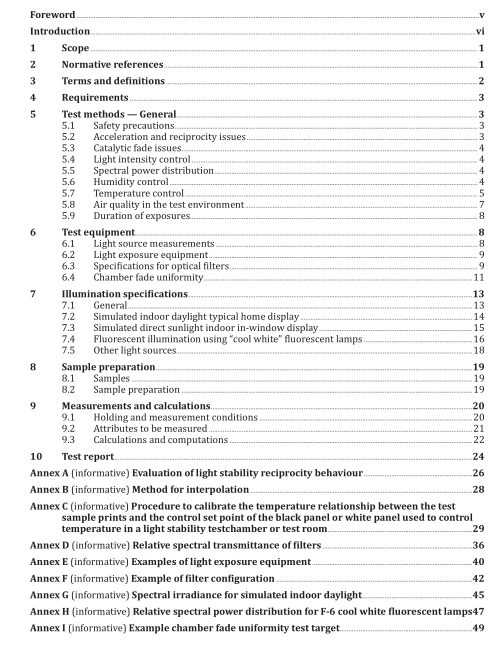BS ISO 18937:2014 pdf download.Imaging materials — Photographic reflection prints — Methods for measuring indoor light stability
4 Requirements
This International Standard specifies a set of recommended test methods with associated requirements for permitted reporting. Data from these tests shall not be used to make life expectancy claims, such as time-based print lifetime claims, either comparative or absolute. Conversion of data obtained from these methods for the purpose of making public statements regarding product life shall be in accordance with the applicable International Standards for specification of print life.
The test methods in this International Standard may be useful as stand-alone test methods for comparison of the stability of image materials with respect to one specific failure mode. Data from the test methods of this International Standard may be used in stand-alone reporting of the absolute or comparative stability of image materials with respect to the specific failure mode dealt with in this International Standard, when reported in compliance with the reporting requirements of this International Standard. Caution shall be used when comparing test results for different materials. Comparisons shall be limited to test cases using equipment with matching specifications and matching test conditions.
The test procedures contained within this standard allow for the use of a variety of light source and filter combinations. Test results obtained using different test conditions, such as different light sources and filters, shall not be compared. Materials under test can be expected to behave quite differently as a result of different relative spectral power distributions of the flux incident on the specimen.
5 Test methods — General
5.1 Safety precautions In light stability tests, high intensity illumination is used, often with significant UV content. Special care shall be taken to avoid eye injury or skin erythema. Precautions should be taken to ensure that the light source cannot inadvertently be viewed without suitable eye and skin protection.
5.2 Acceleration and reciprocity issues
The sample prints to be tested are exposed to laboratory light sources under controlled environmental conditions. Commonly employed accelerated methods of testing light stability, for both photographic digital hardcopy materials and for traditional analog photographic materials, are based on the concept that increasing the light intensity should produce a proportional increase in the photochemical reactions that occur during typical viewing or display conditions, without introducing any undesirable side effects.
However, because of “reciprocity failures” that might be present in high-intensity accelerated light fading tests with imaging materials, this assumption may not always apply (i.e. a material might fade, change colour balance, or stain a different amount when exposed to high-intensity illumination for a short period than it does when exposed to lower-intensity illumination for a longer period, even though the spectral distribution, the total light exposure [intensity × time], the temperature, and the relative humidity are the same in both cases.) [12] − [17][24]
In general, the closer accelerated test conditions are to actual use conditions, the more meaningful the test results become.
For further discussion of approaches to evaluating reciprocity behaviour in the light-induced fading, changes in colour balance, and stain formation in imaging materials, see Annex A.
5.3 Catalytic fade issues Catalytic fade is the process by which a given colourant can fade faster (or slower) when in contact with another colourant as a result of an image area containing more than just one of the colourants. It can also occur when other components in the imaging system act as catalysts. Because this process often involves photocatalysis, it can show a dependency on the nature of the light source as well as the light absorption characteristics of the additional colourant, UV absorbing materials, intentionally-added radical quenchers and other components. [31] Because of these complex interactions, catalytic fade and the resulting nonlinearities can confound predictions of colour fading rates for real-world images.
5.4 Light intensity control The light intensity shall be maintained and controlled throughout testing with an operational fluctuation within ± 7 % of aim. The 24 h running average of the operational fluctuation, sampled at least every 15 min, shall be within ±4 % of aim. The running average shall not include the test condition transition time which occurs when the test condition is initiated. This transition time shall be at most 1 h.
5.5 Spectral power distribution This International Standard references the use of different light sources for accelerated tests with the intention of reproducing as closely as possible different end-use lighting conditions. [25][26] However, no accelerated laboratory exposure test can be specified as a total simulation of actual use conditions. Results obtained from these laboratory accelerated exposures may be considered as representative of actual use exposures only when the degree of correlation has been established for the specific materials being tested and when the type of degradation is the same.
The relative durability of materials in actual use conditions can be very different in different locations because of differences in radiant energy (both in spectra power distribution and intensity), relative humidity, temperature, pollutants, such as ozone, and other factors.BS ISO 18937 pdf download.BS ISO 18937:2014 pdf download
